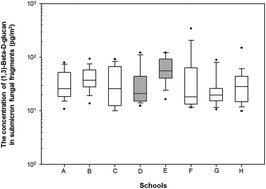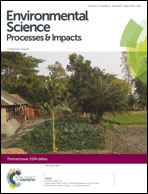Submicron fungal fragments as another indoor biocontaminant in elementary schools
Abstract
There has been great concern about mold in school environments, but few comprehensive assessments of mold have been performed in such settings. Even spore counts or microscopic enumeration only may not be sufficient for evaluating fungal exposure. We explored the levels of submicron fungal fragments with potential heath impact due to their small size in elementary schools and investigated the variation in the concentrations of such particles before and after the rainy season. The concentrations of (1,3)-β-D-glucan in submicron fungal fragments, airborne mold and bacteria, and PM10 were measured both indoors and outdoors in 70 classrooms at 8 elementary schools from May (before the rainy season) to July (after the rainy season) in 2012. Temperature and relative humidity were also monitored. We compared the levels of submicron fungal fragments among schools before and after the rainy season. The associations of the levels of submicron fungal fragments with other variables were analyzed. Overall, the concentrations of (1,3)-β-D-glucan ranged from 10 to 347 pg m−3, and the indoor/outdoor ratios were greater than 1 in every school. After the rainy season, the (1,3)-β-D-glucan concentrations decreased by about 35%, and similar significant decreases in the concentrations of airborne mold and bacteria and PM10 were observed. This difference was prominent for PM10 (P < 0.001). Only relative humidity was negatively associated with the concentration of submicron fungal fragments (P = 0.007). Our findings confirmed the comparable amounts of submicron fungal fragments in school environments. More comprehensive exposure assessments for smaller-sized fungal particles should be performed for better understanding of their health impact, particularly with regard to seasonal changes.


 Please wait while we load your content...
Please wait while we load your content...